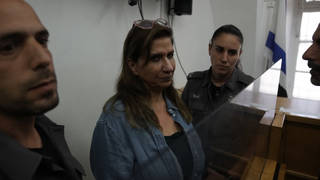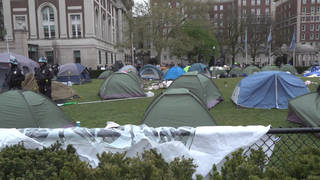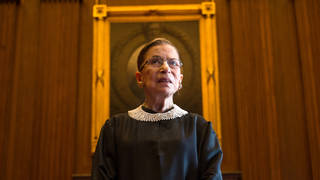
Related
Guests
- Julie Cohenco-director and producer of RBG, which premiered earlier this year at the Sundance Film Festival.
- Betsy Westco-director and producer of the documentary RBG, which has been shortlisted for an Academy Award for Best Documentary.
Links
Supreme Court Justice Ruth Bader Ginsburg has been discharged from the hospital following surgery that removed two malignant growths in her left lung. Doctors called the surgery a success and said there’s no sign that Ginsburg’s cancer has spread. The health of the liberal 85-year-old justice—the oldest sitting justice on the Supreme Court bench—has come under increased scrutiny in recent years. In November, she was hospitalized after a fall that resulted in three fractured ribs. She previously fractured two ribs in 2012 and has twice survived cancer—pancreatic cancer in 2009 and colon cancer in 1999. Despite her illnesses, in her 25 years on the court Ginsburg has never missed a day of oral argument. We turn now to a remarkable award-winning documentary released earlier this year at the Sundance Film Festival. The film has been shortlisted for an Academy Award for Best Documentary. It’s called ”RBG.”
Transcript
AMY GOODMAN: This is Democracy Now!, democracynow.org, The War and Peace Report. I’m Amy Goodman, with Nermeen Shaikh.
NERMEEN SHAIKH: Supreme Court Justice Ruth Bader Ginsburg has been discharged from the hospital following surgery for lung cancer. She’s recovering from the procedure at home. She was hospitalized last week at the Memorial Sloan Kettering Cancer Center in New York, where surgeons on Friday removed two malignant growths in her left lung. Doctors called the surgery a success and said there’s no sign that Ginsburg’s cancer has spread. While in hospital Friday, Ginsburg cast her vote blocking the Trump administration’s asylum ban.
The health of the liberal 85-year-old justice, the oldest sitting justice on the Supreme Court bench, has come under increased scrutiny in recent years. In November, she was hospitalized after a fall that resulted in three fractured ribs. She previously fractured two ribs in 2012 and has twice survived cancer—pancreatic cancer in 2009 and colon cancer in 1999.
AMY GOODMAN: Despite her illnesses, in her 25 years on the bench Justice Ginsburg has never missed a day of oral argument. The court next meets on January 7th. Her return home on Christmas Day coincided with the release of the biopic of her, film titled On the Basis of Sex. But we turn now to a remarkable award-winning documentary released earlier this year at the Sundance Film Festival. The film has just been shortlisted for an Academy Award for Best Documentary. It’s called RBG. This is the trailer.
JUSTICE RUTH BADER GINSBURG: “I ask no favor for my sex. All I ask of our brethren is that they take their feet off our necks.”
ANNOUNCER: We welcome today Justice Ruth Bader Ginsburg.
NINA TOTENBERG: She’s become such an icon.
FAN: Would you mind signing this copy?
JUSTICE RUTH BADER GINSBURG: I am 84 years old, and everyone wants to take a picture with me.
UNIDENTIFIED: Notorious RBG.
UNIDENTIFIED: Yeah, yeah.
GLORIA STEINEM: When you come right down to it, the closest thing to a superhero I know.
NINA TOTENBERG: Ruth Bader Ginsburg changed the way the world is for American women.
JUSTICE RUTH BADER GINSBURG: I became a lawyer when women were not wanted by the legal profession.
NINA TOTENBERG: Thousands of state and federal laws discriminated on the basis of gender. She was following in the footsteps of the battle for racial equality. She wanted equal protection for women.
RUTH BADER GINSBURG: Men and women are persons of equal dignity, and they should count equally before the law.
NINA TOTENBERG: She captured for the male members of the court what it was like to be a second-class citizen.
RUTH BADER GINSBURG: The point is that the discriminatory line almost inevitably hurts women.
JUSTICE RUTH BADER GINSBURG: I did see myself as kind of a kindergarten teacher in those days, because the judges didn’t think sex discrimination existed.
JUDGE RUTH BADER GINSBURG: I have had the great good fortune to share life with a partner, truly extraordinary for his generation.
JUSTICE RUTH BADER GINSBURG: He was the first boy I ever knew who cared that I had a brain.
ARTHUR R. MILLER: She is a center of power, on and off the court.
IRIN CARMON: Every time Justice Ginsburg wrote a dissent, the internet would explode.
AMINATOU SOW: I came up with a couple slogans. “You can’t spell truth without Ruth.”
JUDGE RUTH BADER GINSBURG: I surely would not be in this room today without the determined efforts of men and women who kept dreams alive.
AMY GOODMAN: The trailer for RBG. We’re joined now by the film’s directors, Betsy West and Julie Cohen.
We welcome you back to Democracy Now! Julie, let’s begin with you with the latest on Ruth Bader Ginsburg’s condition. She was just released from the hospital, but tell us what’s happened.
JULIE COHEN: Absolutely. Well, I mean, I’m not an oncologist, but we do know that Justice Ginsburg had the two cancerous nodules removed from her lung. Actually, a lobe of her lung was removed. You’ve got five lobes in your lungs. And one of them, now the justice has had removed. Got out of the hospital after just a few days, about five days total in the hospital, and is now resting, recovering, and with a view towards being on the bench as soon as possible. Note that she scheduled her surgery for the Friday before a long holiday. It’s a long tradition that she has, has done the same thing with chemotherapy, with the idea that you want to have as little possible work downtime so that you can get right back to work.
AMY GOODMAN: Friday was a very busy day. She both had the operation, but she also ruled, participated in a Supreme Court vote. And talk about the significance of that.
JULIE COHEN: Right. I mean, all nine justices had to vote on this brief order that came out, ended up with a 5-to-4 vote. The question—there’s a lot of double negatives, so I’ll just—basically, the question was: Does Donald Trump’s administration’s asylum ban, the restrictions on asylum for immigrants, stand while—during the period that the courts are trying to work out the merits of the issue? And the court voted 5 to 4 that the ban does not stand, with Roberts voting with the court’s liberal wing on this procedural issue. But a 5-to-4 vote is a reminder of the huge importance of each of those nine votes and the importance of Justice Ginsburg weighing in even during her illness.
NERMEEN SHAIKH: Well, as news of her surgery became public, supporters took to Twitter with messages like “She can have my lung. Hell, she can even have both of them.” Earlier this year, fans similarly tweeted messages of support when RBG was hospitalized after a fall that fractured her three ribs. At the time, actress Alyssa Milano wrote, quote, “Ruth Bader Ginsberg [sic] can have my ribs. And my kidneys and a lung. And anything else she needs. She can even have my husband on Thursdays.” So, that was Alyssa Milano’s tweet, and then tweets that came out last week as news of her—earlier this week as news of her surgery spread. So, Betsy West, could you explain why her position on the Supreme Court now is so crucial?
BETSY WEST: Well, you know, Nina Totenberg cracked that maybe we could solve the organ donation problem in this country by taking all of those offers. And, you know, Justice Ginsburg has become a rallying cry for many people in this country who are dismayed by the Supreme Court’s move to the right. And obviously, as Julie just said, the court is now divided very narrowly. And the fact that Chief Justice Roberts joined with the four liberal justices doesn’t always happen. And there are many decisions that come down—they’re expected to come down 5 to 4, five on the conservative side. So she is critical. People see her longevity as absolutely necessary in this time.
NERMEEN SHAIKH: Well, she also—just recently, she hired two law clerks—law clerks for at least two more terms. So the idea is that she will stay ’til 2020, in her own view.
BETSY WEST: Well, yes. I mean, she keeps moving the goal post here. And she had said that in addition to hiring her clerks for the coming two years, which is something that you don’t have to do, she’s now started talking about 90 as—is a goal for her to retire. She’s 85 now, so that gives—
NERMEEN SHAIKH: Five years.
BETSY WEST: —her another five years. You know, you mention all of her illnesses. It’s funny in a way, because when Julie and I were following her around the country, you wouldn’t have known that this was a frail person. She has—yes, she’s small. She’s diminutive. She’s kind of bent over. But she has extraordinary stamina. And she sometimes tired us out, frankly, by the end of the day. We were ready to go to bed, and she was like, “Oh, let’s”—you know, she’d say, “I’m going to go back and do a little bit of work.”
AMY GOODMAN: We’re going to go to a break and then really recap her life, talk about her history of activism, legal prowess, how she came to be on the Supreme Court and has served there for the last quarter of a century. We’re talking to Betsy West and Julie Cohen. They are the directors of the now-Oscar-nominated documentary RBG. Stay with us.
[break]
AMY GOODMAN: “Ruth Bader Ginsburg” by Ann Reed. This is Democracy Now!, democracynow.org, The War and Peace Report. I’m Amy Goodman, with Nermeen Shaikh. We’re talking about the health of and the life of Ruth Bader Ginsburg, on the Supreme Court for the last 25 years. And we’re speaking with the directors of a documentary that’s just been shortlisted for an Oscar. We will see what happens. The shortlist is 15 documentaries, and the nomination process that happens by the end of January will lead to five documentaries chosen. Ruth Bader Ginsburg, though, was nominated by President Clinton in 1993. During her Senate confirmation hearing, she openly defended a woman’s right to have an abortion.
JUDGE RUTH BADER GINSBURG: This is something central to a woman’s life, to her dignity. It’s a decision that she must make for herself. And when government controls that decision for her, she’s being treated as less than a fully adult human responsible for her own choices.
NERMEEN SHAIKH: So, during Ginsburg’s 1993 Supreme Court confirmation hearing, Republican Senator Orrin Hatch of Utah questioned her on abortion.
SEN. ORRIN HATCH: Yesterday you endorsed a so-called constitutional right to abortion, a right which many, including myself, think was created out of thin air by the court.
JUDGE RUTH BADER GINSBURG: But you asked me—
SEN. ORRIN HATCH: Yeah.
JUDGE RUTH BADER GINSBURG: —the question in relation to the Supreme Court’s precedent. And you now ask me another question in relation to the Supreme Court’s precedent. The Supreme Court’s precedent is that access to abortion is part of the liberty guaranteed by the—
SEN. ORRIN HATCH: Well, that was just to be affirmed by—
JUDGE RUTH BADER GINSBURG: —the 14th Amendment.
NERMEEN SHAIKH: So, that’s Ruth Bader Ginsburg in 1993 during her confirmation hearing. She was ultimately confirmed 96 to 3. And among the people who voted to confirm her was Orrin Hatch, who’s anti-choice.
BETSY WEST: Yes. We spoke with Senator Hatch for the documentary. We wondered if, in any way, he regretted that vote or he wanted to, you know, make any qualifications. And he is a very staunch Republican. But I have to say, he told us, “I love Justice Ginsburg.” He made the point, during the hearings, that he disagreed with her on some issues, but not with her qualifications to be a justice. He said, “Look, she was appointed by a liberal president. He has that right. And she deserves to be on the court.” It’s obviously a very different time.
NERMEEN SHAIKH: Well, one of the things that you document so well in the film is her relationship, her very close friendship, with Antonin Scalia.
BETSY WEST: Yes.
NERMEEN SHAIKH: So, I mean, it says something. If you could talk a little bit about where she fell—or, she falls politically, and what people—and in the documentary, you point this out, too, that she’s kind of an accommodationist, right? She works with both conservatives and liberals.
BETSY WEST: Well, she’s very collegial. I would say that she is on the ideological opposite side to Justice Scalia. But she’s a person who believes in talking about your differences, in not—and in having a good relationship with all of her colleagues on the court. Let’s face it, it’s only nine of them, and they’re in that chamber, and they’re talking. And she’s very practical. How is she going to convince people to come over to her side if they’re mad at her, if they don’t like her? I think she—many people said to us beforehand, “Oh, you know, she’s not really friends with Justice Scalia. How could she be friends with a guy like that?” And the reality is that they were extremely good friends. She really loved—they shared opera in common. They both loved opera.
AMY GOODMAN: And acted in an opera.
BETSY WEST: And they acted, yes, together, appeared in an opera; went to lots of opera, talked about opera all the time. And, you know, she loved his sense of humor. And I think, more than that, she respected him intellectually and felt that talking things over with him actually sharpened her own arguments.
AMY GOODMAN: I want to turn to another clip from your documentary, RBG, where Justice Ginsburg talks about the first time she argued before the Supreme Court in the case Frontiero v. Richardson in 1972. The case centered on a female Air Force lieutenant who had been denied the same housing and medical benefits as her male colleagues. Ginsburg argued the Air Force’s statute for housing allowances treated women as inferior, and the Supreme Court ruled in her favor, 8 to 1.
JUSTICE RUTH BADER GINSBURG: There was not a single question. I just went on speaking. And I, at the time, wondered, “Are they just indulging me and not listening, or am I telling them something they haven’t heard before, and are they paying attention?”
BRENDA FEIGEN: The justices were just glued to her. I don’t think they were expecting to have to deal with something as powerful as a shear force of her argument, that was just all-encompassing. And they were there to talk about a little statute in the government code. I mean, it was just—we seized the moment to change American society.
RUTH BADER GINSBURG: In asking the court to declare sex a suspect criterion, we urge a position forcibly stated in 1837 by Sarah Grimké, noted abolitionist and advocate of equal rights for men and women. She said, “I ask no favor for my sex. All I ask of our brethren is that they take their feet off our necks.”
AMY GOODMAN: An excerpt from RBG, the documentary. In that clip, we also heard from Brenda Feigen, who was co-director with Ginsburg of the ACLU’s Women’s Rights Project.
Julie, if you can talk more about her activism, her legal prowess. She went to Harvard, left Harvard—everything she did, she had to challenge her way—because her husband moved to New York. She was first in her class at Harvard, but she had to leave because they wouldn’t let her work—go to school there from New York.
JULIE COHEN: Right. She wanted to finish her senior year at Columbia Law School, which in fact she did and graduated from Columbia. You know, the number of obstacles that RBG has faced in her life—personal, legal, societal—are absolutely enormous.
The fascinating thing about her, and really what prompted Betsy and I to make this film about her, is, as much as people are interested in her now and obsessed with her current “Notorious RBG” persona, the story of her history and what she achieved for equal rights for women under the U.S. Constitution was, in our view, kind of not as widely known as it should be. It’s an incredible story. It’s one of those pieces of history that somehow gets left out of the schoolbooks, like how do—how is it not common knowledge how women’s equal rights under the law were achieved?
Well, a big part of how they were achieved was Ruth Bader Ginsburg as a young lawyer working for the ACLU Women’s Rights Project, which she was a co-founder of, arguing six cases before the U.S. Supreme Court, arguing that under the Equal Protection Clause, men and women should be equals. Seems now like actually not such a radical proposition. At the time she was arguing these cases, in the early ’70s, believe you me, it was a radical notion. She took that idea and made it—made it real and also made it kind of a mainstream concept. Yes, women and men should be equal under the law.
AMY GOODMAN: But she also felt that the battle not only had to be waged in the courts. And I wanted to turn to a moment at the RBG premiere at the Sundance Film Festival earlier this year, when you all came out after the film. And it was quite something, because Justice Ginsburg was there, I believe seeing the film for the first time, and she, too, came down to the front of the theater. And I had a chance to ask Justice Ginsburg about the #MeToo movement and the continuing fight for gender equality.
AMY GOODMAN: As you flew in to Sundance on Saturday, thousands of women around the country were marching, rallying and saying “Me, too” and “Time’s up.” And I’m wondering your thoughts on this movement and whether that demand you made so many decades ago, you feel, still stands—”take the boots off our necks”?
JUSTICE RUTH BADER GINSBURG: I was glad to see that happen, because the march, the first march, Women’s March, was hugely attended, and I wondered whether it would stop with that or whether the movement would continue. And I think yesterday was proof that it will continue. The more women who are out there doing things, the better off all of us will be for it. That’s something that my dear colleague Sandra Day O’Connor often said, that the responsibility of women of our vintage is to get out there and to make a good show. And the more women who are out there doing things, the more younger women will feel—will have the courage to go on. And I’m heartened by the number of women who will be in races for Congress and governorships and state legislative positions. So, it was a favorite expression of Martin Luther King: “The arc of the moral universe is long, but it bends toward justice.” And I added to that: Yes, if there are people who will strive with all their might to see it happen.
AMY GOODMAN: And there is Ruth Bader Ginsburg speaking about the importance of movements, Betsy. Of course, it was before this election, as she is referring to the significance of elections.
BETSY WEST: Yes.
AMY GOODMAN: And famously, though she apologized for it, ahead of the 2016 election, Justice Ginsburg called Donald Trump a “faker” who “says whatever comes into his head at the moment.”
BETSY WEST: Well, yes, she later said that she wished—that she regretted having made those comments. But I think it’s so interesting to see her take on the world. She’s a very optimistic person. And she’s looking at the women who are running, and she’s saying, “Look, here’s some progress.” Look what’s going to happen. She’s kind of predicted. We now have over a hundred women who are going to be going into Congress. It’s still not parity, but it is an improvement over what it was. And I think that’s kind of the way Justice Ginsburg approaches everything. She’s in the minority now, and she says, “I’d rather be writing majority opinions, but if I have to, I’ll write in dissent.” She’ll do her job. And I find it poignant and kind of inspiring, the way she’s always got the half-glass-full approach to life.
AMY GOODMAN: And working out.
BETSY WEST: Yeah.
AMY GOODMAN: I mean, the reason they found the tumors—right?—on her lungs is that she fell in her offices at the Supreme Court—
BETSY WEST: Yeah, right.
AMY GOODMAN: —and she broke some ribs. But that actually may well have saved her.
BETSY WEST: Yeah.
JULIE COHEN: Absolutely, because it led to the scans in which these nodules on her lung were detected.
AMY GOODMAN: But just the week before, she was planking, right? She was working out.
BETSY WEST: Oh, all the time.
JULIE COHEN: Just before, she was planking. And actually, in between—
AMY GOODMAN: But explain what that means, for people who don’t know.
JULIE COHEN: Do you want me to demonstrate on the table? Planking is what—you put yourself in a prone position and rest on your toes. It really works out your abs.
AMY GOODMAN: But she works out with a trainer.
JULIE COHEN: Justice Ginsburg works out with her personal trainer, Bryant Johnson, whose main fitness training is actually with members of—with soldiers, because he’s in the U.S. Army Reserves. He says—and he’s not being facetious—that Justice Ginsburg is tougher than the young soldiers that he works out, because she never gives him any lip. He tells her to do something, and she just wants to get it right. Between the rib fracture and this recent cancer surgery, she was back in the gym, you know, trying to keep herself fit.
AMY GOODMAN: And you two are paving the way with being a women-led team who did this documentary. It’s what? The most—what? Twenty-second most successful documentary of all time. Congratulations.
JULIE COHEN: Thank you.
AMY GOODMAN: You just won the duPont-Columbia Award and are shortlisted for an Oscar. So, congratulations to both of you.
BETSY WEST: Thank you.
AMY GOODMAN: Very significant film. It’s streaming also on Hulu now?
BETSY WEST: Yes.
JULIE COHEN: Right.
BETSY WEST: Yes. Thank you.
AMY GOODMAN: Betsy West and Julie Cohen, directors and producers of the documentary RBG. To see our hour with them at Sundance, you can go to
democracynow.org.
That does it for our broadcast. Democracy Now! has an immediate job opening for a full-time social media manager here in New York. Résumés go to democracynow.org.












Media Options